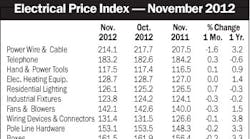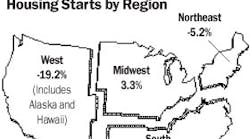Latest from Mag
People - Dec 21, 2012
Obituaries - Dec 21, 2012
November EPI Index Shows No Change
Housing Starts Dip 4% in November
Electrical Marketing - December 21, 2012
Around the Industry - Dec 21, 2012
The recent bump in the price of copper has little to do with underlying fundamentals of supply and demand for the electrical industry's favorite metal. Countervailing forces in the world economy, combined with uncertainties about the size and movement of metals inventories within China, suggest that the dislocation between price and fundamentals may well continue.
Copper hit the highest prices seen in the past five months last week, peaking at $3.85 per pound on the Comex market and $8,411 per tonne (metric ton) on the London Metals Exchange (LME). This week it has given back some ground, closing Sept. 19 at $3.83/lb and $8,330/tonne for three-month contracts, still well above the year-to-date averages in the $3.60/lb range.
The run-up last week was due to three primary factors — the announcement by the European Central Bank (ECB) of a new bond-buying program to support debt markets in Europe, anticipation of a third round of quantitative easing (QE3) by the U.S. Federal Reserve and an announcement by China that it would invest 1 trillion yuan (about $158 billion) in infrastructure projects to boost its economy, said John Gross, a long-time copper market analyst and publisher of The Copper Journal.
As a result, said Gross, “We had the dollar go down, and all metals, base metals as well as precious metals, moving higher in response to that weaker dollar. The markets are not necessarily moving higher based on stronger fundamentals, but rather on central bank easing here and in Europe, and on the Chinese side with their infrastructure projects, and that has brought copper up to a multi-month high.”
China's infrastructure program, a mix of highways, ports and airport runways, came amid successive months of slowing economic growth in the country whose consumption of copper accounts for more than 40 percent of global demand. A report this week from HSBC and Markit found manufacturing output in China fell for the 11th straight month.
Getting a bead on China's actual consumption of copper is as difficult as it is critical to estimating future demand for copper. “Part of the difficulty is we don't have good transparency on China's statistics,” Gross said. “We can track the Shanghai inventories, but the copper that's in bonded warehouses remains a mystery to the market overall. There are assumptions out there that the metal has moved from 500,000 tonnes to 600,000 tonnes in bonded warehouses. But there's no way to tell. It's just an assumption that people have. That has created uncertainty in the market. That is, in part why we talk about copper being in deficit, because metal is going to China and statistically the assumption is that it's being consumed, and that's not necessarily the case.”
Reports over the past few months from Reuters, The Wall Street Journal and Bloomberg have found surprising inventories of copper at warehouses in China, a large part of which are believed to be “encumbered” — used as collateral to secure loans — so are not counted in inventory because they are not available for sale. This raises questions about whether or when these supplies might flood back onto the market.
Gross points out that the reports of such “dark inventory” have been circulating for awhile, and are already part of commodities investors' considerations when buying or selling copper. “Unless we have some hard facts, I tend to ignore it because you can't act on it. But it does raise a cautionary flag, to say don't become too complacent about high prices persisting, because as China goes, so goes the market,” he said.
Whether the longer-term outlook for copper prices points up or down may depend on the length of that longer term. Over the course of the next few years, there are conflicting opinions, with some saying an increase in copper production will push down prices. Looking decades ahead, however, fundamental demographics in developing countries suggest demand for infrastructure, machinery and luxuries using copper will continue getting stronger.

